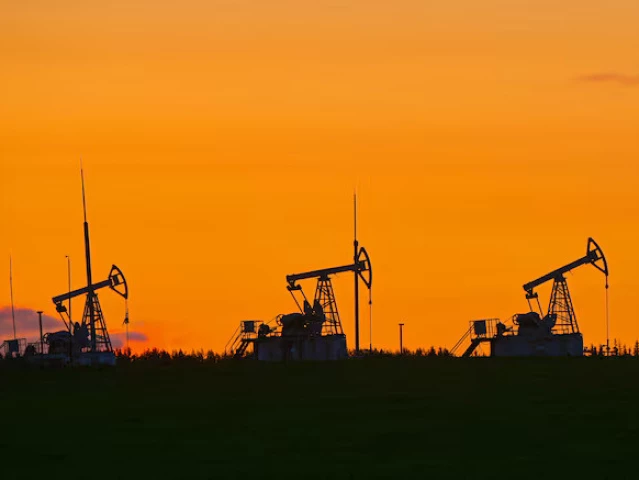Business
Algorithm rush: belated entry into modern trading | The Express Tribune

ISLAMABAD:
When we think of artificial intelligence (AI), our minds often jump to Hollywood blockbusters, imagining futuristic machines from I, Robot or The Terminator. Though the idea of intelligent robots in public assistance roles is still a few years away, AI algorithms already rule the global financial markets as of now.
With intelligent algorithms executing global trade of over $21 billion, human judgement no longer drives price action. Intelligent bots rip through order books in microseconds – exploiting inefficiencies invisible to the naked eye. These machines don’t debate value; they weaponise speed. A single line of code misfiring can erase billions before anyone blinks. Pakistan, meanwhile, is still writing its rulebook. The Securities and Exchange Commission of Pakistan (SECP) has finally realised the importance to regulate algorithmic trade space and is rushing to catch up with a technological revolution that has transformed global finance over the past two decades.
Proponents claim that algorithmic trading removes fallible human emotion from trading decisions and makes markets run more smoothly. However, many algorithms feed off trends from X (formerly Twitter), news headlines and other feeds, which implies they can still be affected by human herd mentality. This often results in amplification of price movements – with a possibility of market crash. In 2012, the US Knight Capital Group went bankrupt after it lost more than $450 million when its AI systems made erroneous orders that couldn’t be undone. Similarly, in 2014, a small over-the-counter trade in Japanese stock market led to an avalanche effect of trades amounting to $617 billion. Similarly, we had pound’s flash crash in 2016 due to rogue computer trades, misjudging market sentiments during Brexit negotiations.
Learning lessons from history, it would be wrong to assume that the Pakistan Stock Exchange (PSX) can handle the surge from algorithmic trading volumes and speeds. We need to forecast potential algorithmic trade scenarios and determine minimum technical requirements for microsecond trading algorithms. This is necessary to avoid system crashes and trading halts. Moreover, it is important to see if we possess adequate oversight capabilities and technical expertise to monitor microsecond trading patterns effectively.
The SECP has recommended to initially restrict algorithmic trading to institutional investors, which while prudent, creates a two-tier market that may disadvantage smaller players permanently. India’s experience shows that retail traders eventually demand access, and often get it through less regulated channels. Similarly, the proposed concept paper by SECP mandates “Initial Conformance Tests” and periodic testing, it lacks detail on stress-testing scenarios. While mandating kill switches, the proposed framework doesn’t specify response times or coordination mechanisms during market-wide disruptions. The 2010 Flash Crash in the US demonstrated that individual kill switches may be insufficient during systemic events.
Before approving any algorithms, the PSX must demonstrate that its systems can handle microsecond trading and massive order flows. The framework should mandate minimum technical standards and redundancies. Secondly, instead of a binary institutional/retail split, it may create a graduated system based on financial sophistication, capital requirements, and risk management capabilities. This could include certified retail traders and smaller institutional players.
Thirdly, the PSX needs to implement comprehensive market surveillance systems capable of detecting manipulation patterns across multiple algorithms and timeframes. The current framework’s emphasis on post-trade analysis may be insufficient.
Pakistan stands at a critical juncture. The global trend towards algorithmic trading is irreversible, and the country cannot afford to remain analogue while regional competitors leverage technological advantages.
India’s messy experience with retail algorithmic trading offers important lessons, but Pakistan’s delayed entry also provides opportunities to learn from others’ mistakes.
The writer is a Cambridge graduate and is working as a strategy consultant
Business
Tata Group Tussle: What’s Behind The Boardroom Rumblings And Tata Sons Listing Row

The Tata Group, one of India’s largest and most respected business conglomerates, is facing growing internal differences over whether its parent company, Tata Sons, should be listed on the stock market. Tata Sons is the unlisted holding company that controls the Tata Group’s vast network of businesses — including Tata Steel, Tata Motors, Tata Consultancy Services, and Air India. According to its 2024–25 annual report, it holds stakes in 355 subsidiaries, 39 joint ventures, and 48 associate companies, and received Rs 36,149 crore in dividends from them last year, reported Mint
Because Tata Sons is unlisted, its shareholders cannot easily sell or “monetize” their holdings. The SP Group, which has been part of Tata Sons since the 1930s, has long wanted a listing to unlock the value of its stake — estimated between Rs 1.5 trillion and Rs 3 trillion, said reports.
The Core Dispute
The SP Group’s demand for listing gained momentum after its representative, Cyrus Mistry, was removed as Tata Sons chairman in 2016, a move that led to a bitter legal and personal fallout between the two groups.
The SP Group, which faces significant debt in its construction and infrastructure businesses, sees the listing as a way to raise funds and strengthen its finances. Earlier this year, credit rating agency ICRA reaffirmed a ‘BBB’ rating with a negative outlook for Shapoorji Pallonji and Company Pvt. Ltd., pointing to continued pressure on liquidity, said reports.
In contrast, Tata Trusts, which uses its dividends from Tata Sons to fund large-scale philanthropic projects, has no such financial pressure. In 2024–25, it disbursed Rs 902 crore in grants, with most funds directed to social and institutional programs. The Trusts also influence key decisions within Tata Sons, including top appointments and governance matters, and want the group to retain its private, long-term structure. Meanwhile, as per PTI reports, Tata Trusts has circulated a proposal to reappoint Mehli Mistry as a trustee for three of its key philanthropic bodies, a move that would make him a lifetime trustee.
RBI’s Role and the Listing Deadline
The Reserve Bank of India (RBI) added to the tension in September 2022, when it classified Tata Sons as an “upper-layer” non-banking financial company (NBFC) — a category that required the company to list its shares within three years, by September 2025.
However, Tata Sons moved to avoid that requirement by retiring debt and surrendering its NBFC licence earlier this year. This would allow it to remain a privately held company. The company is currently awaiting RBI’s approval for its deregistration.
The RBI’s silence on the matter since then has raised eyebrows among market watchers, with some questioning whether the central bank will enforce the original listing rule or allow Tata Sons to remain private.
What’s At Stake
According to experts, for the SP Group, listing Tata Sons could unlock much-needed value and ease its debt burden. In a recent statement, the group called the listing a “moral and social imperative,” arguing that it would “unlock immense value for over 1.2 crore shareholders of listed Tata companies who indirectly have a stake in Tata Sons.”
The Shapoorji Pallonji (SP) Group has renewed its call for public listing. In a strongly worded statement, the group described the IPO as “a moral and social imperative”, saying it would “unlock immense value for over 1.2 crore shareholders of listed Tata companies.
For Tata Trusts, however, a public listing could mean less control over the company that anchors the entire Tata empire. The Trusts’ leadership believes the current structure — where dividends from Tata companies fund its philanthropic work — best preserves the vision of Jamsetji Tata, the group’s founder, noted analysts.
Business
Emissions from UK residents and businesses fell by 0.5% in 2024, data shows

Greenhouse gas emissions generated by UK residents and businesses both at home and abroad fell by 0.5% in 2024, provisional figures show.
The Office for National Statistics (ONS) said on Friday that the UK’s so-called “residential basis” emissions were 476 million tonnes of carbon dioxide equivalent (CO2e) in 2024.
This was 43.3% below levels in 1990 – the first year the ONS has data for.
Residence basis emissions cover those generated by British residents and businesses regardless of where they occur geographically.
The 0.5% fall from 2023 continues a general downward trend since the data time series began in 1990.
The manufacturing industry was the largest contributor to this total decrease in 2024, falling by 7.4% from 2023, according to the ONS.
Meanwhile, consumer spending remained the largest single contributor to UK emissions on a residence basis, at 26.0% of the 2024 UK total, the figures show.
These emissions were found to have risen by 1.7% in 2024 compared with 2023, marking the first time annual consumer expenditure emissions have increased since 2021, during the coronavirus pandemic.
This rise was largely driven by a 4.1% increase in residential natural gas combustion, the ONS said.
The second largest contributor to the UK’s emissions last year was found to be the transport sector at 16.1%.
It came after emissions from this industry increased by 4.5% in 2024, continuing a general rise for transport since 2021.
The ONS also published figures on changes in UK emissions intensity – which measures environmental efficiency by comparing the quantity of emissions to the economic output.
Between 2023 and 2024, UK emissions intensity fell from 0.16 to 0.15 thousand tonnes of CO2e per million pounds of gross value added (GVA).
Residence basis emissions, which are published by the ONS, can include emissions generated by UK residents overseas, such as travel, and from UK-registered companies operating abroad but they exclude those generated within the UK by foreign residents and businesses.
They differ from the Energy Department’s (Desnz) figures – last released in March – that calculate the emissions generated within the UK’s borders.
In 2024, these territorial emissions were 371.4 million tonnes of carbon equivalent – which was 3.5% lower than 2023 and 54.2% lower than 1990.
Business
47.7% of Mutual Fund Assets Now Invested Directly, ICRA Analytics Says

Last Updated:
ICRA Analytics reports 65.30 percent retail investors used Non-Associate Distributors, while 27.37 percent invested directly.

Retail Investors Prefer Distributor Route; Direct Investments at 27.37%: ICRA Analytics
Approximately 27.37% of retail investors opted for direct investments, while 65.30% of retail investors came through the route of Non-Associate Distributors as of September 30, according to ICRA Analytics. Additionally, 47.70% of the mutual fund industry’s assets were invested directly and 45.96% came from Non-Associate Distributors, ICRA Analytics added.
Direct investment refers to investment directly with the mutual fund company (AMC), where there is no commissions or intermediary fees, making the expense ratio (cost of managing the fund) lower.
Data from AMFI showed that 19% of the assets of the mutual fund industry came from B30 locations in Sep 2025. Assets from B30 locations increased from Rs 14.14 trillion in Aug 25 to Rs 14.50 trillion in Sep 25, representing growth of 2.6%. B30 means Beyond Top 30 cities, including all other smaller towns and cities outside those top 30 (T30) cities.
Assets from T30 locations also grew 14% on a yearly basis in Sep 2025.
B30 location continued to tend towards equity assets. “Nearly 76.60% of the assets from B30 locations are in equity schemes and 9.12% in balanced schemes in Sep 2025,” ICRA Analytics added.
Close to 11.67% of the assets from B30 location are in debt-oriented schemes, while the same from T30 location accounts for 30.39%.
Nearly 28.90% of High Net Worth Individual (HNI) assets were directly invested.
ICRA Analytics earlier said that domestic equity markets rose following robust macroeconomic indicators, as India’s economy expanded by 7.8% YoY in Q1 FY26, marking the strongest growth in five quarters, while the Services PMI surged to 62.9 in Aug 2025. its highest level in over 15 years, driven by a sharp rise in new orders and resilient demand.
Sentiment was further boosted as the GST Council simplified the existing four tax slabs (5%, 12%, 18%, 28%) into a two-rate structure of 5% & 18% and proposed a special 40% slab for select luxury items such as high-end cars, tobacco, and cigarettes. Gains extended after the U.S. Federal Reserve delivered its first rate cut of the year in Sep 2025, citing recent weakness in the labor market. However, overall gains were capped amid lingering uncertainty over India–U.S. trade negotiations and continued foreign institutional investor outflows from domestic equities.

Varun Yadav is a Sub Editor at News18 Business Digital. He writes articles on markets, personal finance, technology, and more. He completed his post-graduation diploma in English Journalism from the Indian Inst…Read More
Varun Yadav is a Sub Editor at News18 Business Digital. He writes articles on markets, personal finance, technology, and more. He completed his post-graduation diploma in English Journalism from the Indian Inst… Read More
October 24, 2025, 18:16 IST
Read More
-

 Tech1 week ago
Tech1 week agoWhy the F5 Hack Created an ‘Imminent Threat’ for Thousands of Networks
-

 Tech5 days ago
Tech5 days agoHow to Protect Yourself Against Getting Locked Out of Your Cloud Accounts
-

 Business1 week ago
Business1 week agoBaroness Mone-linked PPE firm misses deadline to pay £122m
-

 Sports6 days ago
Sports6 days agoPCB confirms Tri-nation T20 series to go ahead despite Afghanistan’s withdrawal – SUCH TV
-

 Sports1 week ago
Sports1 week agoU.S. Soccer recommends extending NCAA season
-

 Tech6 days ago
Tech6 days agoI Tested Over 40 Heat Protectant Sprays to Find the Best of the Best
-

 Tech6 days ago
Tech6 days agoUS court bars NSO Group from installing spyware on WhatsApp
-

 Tech5 days ago
Tech5 days agoThe DeltaForce 65 Brings Das Keyboard Into the Modern Keyboard Era—for Better or Worse












